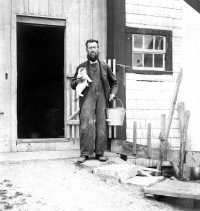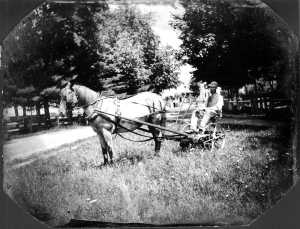Sign up for the Family Tree Newsletter Plus, you’ll receive our 10 Essential Genealogy Research Forms PDF as a special thank you!
Get Your Free Genealogy Forms
"*" indicates required fields
 |
 |
| Figure 1 | Figure 2 |
Is there a photograph that led you to new information about your family? Have you successfully identified photographs in your family album? I would love to hear about your successes and share them in an upcoming article in Family Tree Magazine. If I include your story in the article, you will win a free copy of my new book,Preserving Your Family Photographs. Hope to hear from you soon at mtaylor@taylorandstrong.com.
One reader is especially lucky. Not only does Marilyn Day have family photographs, they are identified! She wanted to share her story with readers of this column.
In 1851, John Day (born in 1805), son of Issac and Lucy (Dutton) Day, purchased a farm in Westford, Mass. When Marilyn and her husband acquired the house in 1972, they discovered about 300 glass negatives taken by Quincy Day, John’s grandson. Like so many farms, little is left of it today, but the memories still exist in those glass plate negatives. Marilyn began researching the family and eventually published her findings in a book, Westford Days.
In 1859, at age 17, Emma Merriam Sprague married John Warren Day, son of John Day, in Westford, Mass. They lived the rest of their lives in the house at 47 Graniteville Road. By 1863, Emma had already buried her first-born child, a daughter named Hattie Maria born Aug. 17, 1861, who died at 2 of diphtheria. Of Emma and John Warren Day’s five children, only two would survive to have children of their own. In 1865, Emma and John Warren had another daughter, Ada Merriam Day.
Along with the glass negatives, Marilyn found diaries written by Emma, John Warren and Ada. They wrote about the people they encountered, about people who visited, about births, marriages and deaths, and it is the names extracted from these diaries which have been identified and researched.
These two images are just a couple from the family collection. Figure 1 is John Warren Day in work clothes holding a cat. Notice that underneath his work overalls he has on a shirt and a tie. It was taken by John Warren Day’s son, Quincy Day.
Emma Day actually mentioned Figure 2 in her diary for 1871: June 28: “We rode over to the picture man.” July 13: “Warren got his picture on the machine and Kate, got it all framed.” According to Marilyn, Kate is the horse. The Days named each of their horses Kate. This tintype remains in the family and is a cherished part of their collection. While John Warren Day has his shirtsleeves rolled up for work, he is still wearing a vest and tie. Not all men dressed formally for farm work; usually men’s work clothing reflected a trade, but vests were common with collarless work shirts. Ties were optional for laborers, but not for office attire.
Wouldn’t you like to leave identified photographs behind for your descendants? It is easy to do. Start with your next roll of film and record when the pictures were taken, who is in them and why they are important. Copy Emma Day and mention the information in your journal. Your family will appreciate for generations to come.
How many readers of this column have stories about their family photographs? Don’t forget to send them to me. I’m sure readers would be interested in what you’ve learned and be encouraged by your successes.
Find out how to submit your own picture for possible analysis by Maureen Taylor. E-mail her at mtaylor@taylorandstrong.com.
ADVERTISEMENT

